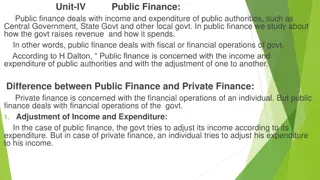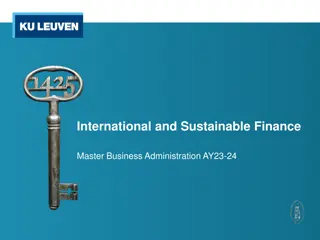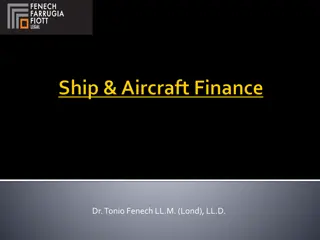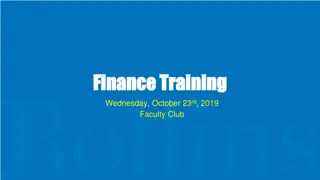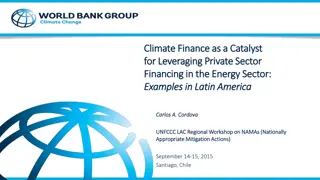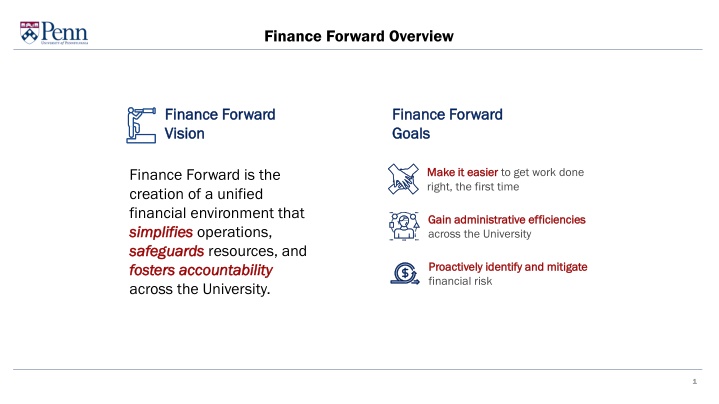
Unified Financial Environment: Initiatives and Strategies for Efficiency
Learn about Finance Forward's vision and goals for creating a unified financial environment at the University to enhance operations, resource management, and accountability. Explore key projects such as School Compliance Dashboard and Procurement Transformation, and understand the impact of the HAAS study on administrative activities.
Download Presentation

Please find below an Image/Link to download the presentation.
The content on the website is provided AS IS for your information and personal use only. It may not be sold, licensed, or shared on other websites without obtaining consent from the author. If you encounter any issues during the download, it is possible that the publisher has removed the file from their server.
You are allowed to download the files provided on this website for personal or commercial use, subject to the condition that they are used lawfully. All files are the property of their respective owners.
The content on the website is provided AS IS for your information and personal use only. It may not be sold, licensed, or shared on other websites without obtaining consent from the author.
E N D
Presentation Transcript
Finance Forward Overview Finance Forward Finance Forward Vision Vision Finance Forward Finance Forward Goals Goals Make it easier Make it easier to get work done right, the first time Finance Forward is the creation of a unified financial environment that simplifies simplifies operations, safeguards safeguards resources, and fosters accountability fosters accountability across the University. Gain administrative efficiencies Gain administrative efficiencies across the University Proactively identify and mitigate Proactively identify and mitigate financial risk 1
Key Projects Finance Forward has identified and prioritized a portfolio of projects that will achieve the overall goals of the Program. Each project will be enabled by resources and capabilities to ensure success while helping build change resilience. C CURRENT URRENT P PROJECTS ROJECTS I INCLUDE NCLUDE: : School Compliance School Compliance Dashboard Dashboard (Operational) Procurement Procurement Transformation Transformation Research Services/ Research Services/ PennERA PennERA Payroll Payroll Implemented in 2024, the dashboard provides greater visibility across the University s compliance metrics. The Procurement Transformation seeks to advance the overall procurement function to bring efficiencies into how the University sources, buys, and pays for products, services, travel, and other expenses. Evaluation of options for upgrading Penn s research lifecycle management system, focusing on the complete grant lifecycle, in partnership with the Sr. Vice Provost for Research. The Payroll initiative seeks to reduce errors and improve accuracy through updated processes, technology enhancements, and improved monitoring and controls. 2
Completing the Picture Building on the qualitative feedback and quantitative data points collected, the Higher Education Building on the qualitative feedback and quantitative data points collected, the Higher Education Administrative Activity Study (HAAS) will provide input to both Central and Schools/Centers on: Administrative Activity Study (HAAS) will provide input to both Central and Schools/Centers on: Level of Effort Distribution of Effort Role Portfolio How many people and hours hours does it take to complete specific administrative activities today? people How is administrative administrative work distributed work distributed both within and across S/Cs and Central DoF? Where is there duplication? What are the titles roles roles that support these administrative activities? Are they generalists or generalists or specialists specialists? titles & 3
How Data is Captured with HAAS HAAS data is generated by participants selecting the functions in which they work, how much time they spend on those functions, and how much time they spend on sub activities within each function. Question 1 Question 1. Participants select functional area(s) area(s) in which they work select functional Question 2 Question 2. Participants allocate the hours in which they work in each functional area in each functional area allocate the hours Question 3 Question 3. Participants allocate hours spent on sub spent on sub- -activities activities within a function hours 4






